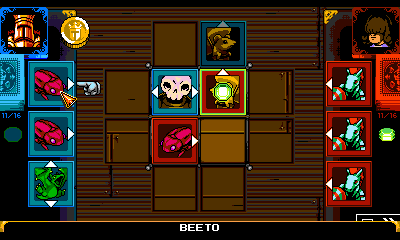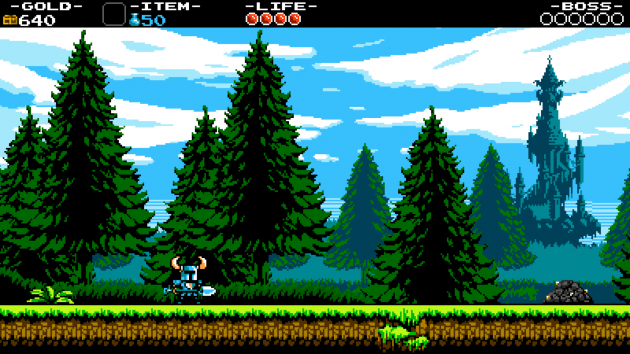Whether you are playing a single-sitting adventure or grinding out the 80th hour of an epic, every minute you spend playing a game is precious. As game developers, it’s our responsibility to make sure that we are respectful of the time that you choose to spend playing our games. Today, we’d like to spend a little time explaining how we account for a player’s time during the development of Shovel Knight: Treasure Trove, and what that means in practice!

What is a good use of someone’s time?! How should one spend one’s time on earth? Is any single activity worth your time over any other...? Oh no, we are falling down an existential hole!
The Value of Time
Time can be a determining factor in shaping a player’s decision to buy a game! Some players measure a game’s value based on the average hours required to finish it, while others focus on replayability or the quality of their time spent, even if a game’s duration was short. Players value their game time in all kinds of different ways, so what are actual best practices for addressing the needs of every player?
To us, it really depends on the goals of the game, and you can’t have it all ways. We can only really say what valuing a player’s time means to our own games, and that comes down to our company philosophy. At Yacht Club Games, we put a high premium on gameplay time, meaning the experience of actively playing and controlling the game. We want players to come away thinking that nothing got in the way of a pure gameplay experience. There are other elements of a game that we also value tremendously: story, art, music, animation… but our main goal is to have those elements work to amplify the gameplay. We want players to buy and play our games because they find every moment crammed with great gameplay!
So, let’s take a look at how we try to design around valuing a player’s sense of time in a Shovel Knight game. What are ways we maximize time spent playing?
Skipping the Story!
We work really hard to craft a great story for players who find that experience motivating and valuable. It’s important to keep in mind that some players don’t need it! Especially when they are playing the game a second (or third, or hundredth time). Even in our favorite games, we don’t want to be forced to sit through unplayable parts.
Here are a few examples of how we provide players ways to advance in the game without feeling bogged down by the story:

Holding a button makes the text print out super fast!

Pressing start skips all dialogue prompts altogether!

Don't worry! if there’s a question that could influence a player's gameplay experience, pressing start will advance you straight to it.

On a return visit to a boss, players won't encounter repeat dialogue.

All cut scenes are skippable, even the first time you play.
There are brief moments where we do make players wait. For example, we thought it was important to demarcate a level’s introduction for a few moments. It’s a time for players to take in the view, collect their thoughts, and prepare for what’s ahead.

Even though it’s only a second, we take these wait times very seriously. It has to be worth it!
Blending Story and Gameplay
Keep the Text Short!
We put a high value on keeping text as condensed as possible, especially since we’re hoping to accommodate many reading levels. We deliberately keep our text boxes small to keep the text short and to the point. The less time players spend reading, the more time they’ll be playing.

Our dialogue box supports 3 lines of text in one box. Any time we go over that limit, we consider it a failing!
Story Through Gameplay
Story inherently takes you away from playing the game if delivered through an unplayable cutscene or stationary dialogue exchanges… but if story can be combined with gameplay, then we’re maximizing both aspects! Shovel of Hope’s playable dream sequences and Specter of Torment’s flashbacks are prime examples of this. Best of all, those who might usually skip the story might still be drawn in through the fun gameplay:
The idea of playable story extends to background story telling as well. Even if players aren’t reading every line of dialogue, just seeing something like the Tower of Fate looming in the background provides a clear sense of the threat and a clue to the player’s objective. By using the gameplay space effectively, there’s a lot we don’t need to say directly to the players.
Avoiding Tutorials
Heavy-handed tutorials take a lot of time and keep players from playing the game freely. So, we try to teach through gameplay as much as possible and make learning natural. Even still, we have found tutorials to be necessary occasionally, like teaching the card game Joustus in King of Cards.

Sometimes, we’ll insert tutorials only for players who have already failed to figure things out naturally! This way, not everyone has to see it.

Replaying Content
Respawning and Checkpoint Distances
Being forced to replay content is a classic pain point for players. We wrote at length about our checkpoint design, but our goal with Shovel Knight has been to deliver as much balanced gameplay as possible in between sections of the game, so players had to learn and master each piece of content. We tried not to make any long stretches without checkpoints, or put in way too many – playing a too-easy game would be a waste of the player’s time, too!

Death and the wait to respawn can be excruciating in some games (especially those with long load times), but in other games (like Super Meat Boy), respawning is almost instantaneous. In Shovel Knight, we tried to get players back into the action as quickly as we could, while still making sure the checkpoint/tally screen clearly conveyed the information players needed to know. We wanted death to be impactful enough for the player, but that meant they needed to understand what had happened.
Along the same lines, some players love scouring levels for secrets, and others hate missing out on anything hidden. It’s important to let these types of players know when they can move on, so we try to indicate when a portion of gameplay is complete. Levels are replayable in Shovel Knight, but we do a lot to discourage players from replaying them, whether that’s labeling the stage as “Clear,” covering a level node with a Shovel Knight head, spawning new exciting encounters, or making sure players are likely to leave a stage with lots of gold.

Hopefully, these types of measures work to remove anxiety about missing items, excessive grinding, and keep players focused on moving forward.

We can save time and relieve anxiety about missing items by displaying the information clearly for you on the map.
Since we wanted to discourage grinding, we tried to keep the focus on making it feasible to get the needed gold and collectibles on a player’s first trip through the stage. However, this meant we had to strongly discourage players thinking that they could exit a level and save their progress. So, we were trapped in a situation where we had to favor one kind of time saving over another.
Effectively Keeping Immersion
Speed of Content
We have a made-up metric called “gameplay per tile”, meaning cramming as much to do as possible within a given space! Though breathing room is a must, there shouldn’t be a wait between interesting moments. We often try to make our ideas as dense as possible without overwhelming the player.

Even when a room appears empty, there’s a lot to do
We’d like to note that this doesn’t mean that the running speed of a game character has to be fast, or that it’s bad to be slow or deliberate! A game can be designed to work with the speed of pretty much any character!
Finally, we want to make sure nothing is timed to make the player wait. You shouldn’t be tapping your foot waiting for a platform to arrive near you. This type of syncing up takes a lot of work, as we’re often balancing for novice and expert players around the same mechanics.

Object Interaction Design!
A big focus in designing our enemies and objects is how to avoid long interaction wait times, so you can feel in control. For instance, you can follow up hitting enemies with more hits immediately. Enemies and objects almost never put you into a state where you can’t continue interacting with them, and everything is generally placed in a way to ensure they’re easy to interact with. Finally, we make sure that objects rarely remove player control.
Rarely does an enemy or boss put up an impenetrable shield for a determinate amount of time, or fly totally out of reach. We try very hard to make sure that bosses are always damageable/interactable, even if only with advanced mechanics or a single relic.

No Load Times!
Nothing keeps you from gameplay more obviously than a loading screen. That even means in game “loading scenes” like opening a slowly-opening door or taking an elevator of indeterminate length. On platforms like the 3DS, where fast loading is more challenging to implement, we go to great lengths to make sure our load times are short. We’ve made sure no load time ever surpasses 5 seconds on the 3DS (with most being far less than a second). We also make sure that if a player respawns into the same stage, the load time doesn’t happen again! That also applies to booting into the game! Our load time to begin Shovel Knight is as fast as we can make it… a player can go from the title screen to playing the game pretty dang fast!

Fast Menus
Surprisingly, menus can take up a lot of your gameplay time! Some games have lots of menus and make that a big part of their gameplay. But in an action game like Shovel Knight, it’s rare that we actually want you in a menu. In Plague of Shadows, which was more menu-heavy, we even accelerated the menu opening speed to save time!

This wasn’t fast enough though, so we added quick select menus to let you avoid the big menu altogether.
We categorized NPCs in order to avoid nested menus or large menus that made it hard to make quick decisions. Each character provides a specific type of item so the navigation experience could be as fast as possible!

The cursor moves as fast as you can press it!
Speeding Up Gameplay
Sometimes, it just is too much to wait for anything! For example, Joustus in King of Cards (similar to the Streetpass games for the 3DS) can be fast-forwarded up by holding a button during gameplay.
In Conclusion – Time Well Spent!
Hopefully this article has provided a better sense of how we think about maximizing players’ time here at the Yacht Club. We’d like to note that these ideas might not apply to every game- some games need to be a quick breeze, and some more slow and deliberate. How players’ time is handled in any area creates a unique feeling game. Not every game should feel like Shovel Knight! But maybe the lessons we learned can help you understand what might work best for yours, or help you notice something about a game you’ve played before. Hopefully this article didn’t waste your time! Now wouldn’t that be the worst?!







